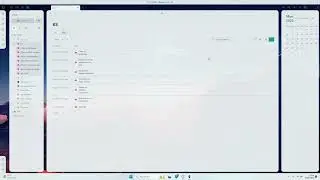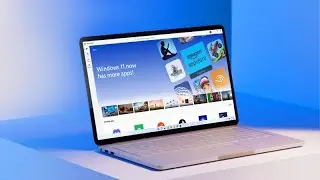[TESTING] Installing Windows 10 LTSC 2019 on a Virtual Machine [2021]
As with all Windows 10 operating system choices, there are pros and cons. Let's have a closer look at the concept behind the acronym LTSC and the considerations for adopting it for your broader user base.
Windows 10 LTSC (formerly known as LTSB) is the lightest, fastest and most stable version of Windows. Is it good for a regular user?
➤ TRY WINDOWS 10 LTSC: https://www.microsoft.com/en-us/evalc...
Windows 10 LTSC Use-Cases
The Long-Term Servicing Channel (LTSC) is designed for Windows 10 devices and use cases where the key requirement is that functionality and features don’t change over time. Examples include medical systems, industrial process controllers, and air traffic control devices.
These devices share characteristics of embedded systems: they are typically designed for a specific purpose and are developed, tested, and certified before use.
What Is The Long-Term Servicing Channel (LTSC)?
The Long-Term Servicing Channel (LTSC), also formerly known as the Long-Term Service Branch (LTSB), refers to a specialized Windows 10 edition specifically designed for scenarios and devices that require feature consistency, such as Point-of-Sale terminals, medical equipment, industrial process controllers, ATMs and air traffic control devices.
If this sounds a lot like embedded devices to you, you are on to something. In fact, as Microsoft consultant Greg Nottage noted in his blog post, the "LTSC 2016 shares the same codebase as Windows 10 IoT, which is the evolution of Windows Embedded OS."
Because these systems typically have been carefully developed and thoroughly tested for a specific purpose only, it would be counterproductive to upgrade their OS every 6-12 months. However, Microsoft will be cutting from ten years to five the length of time it will support the Windows 10 Enterprise LTSC releases, starting with the one coming in the second half of calendar 2021 -- which should be Windows 10 21H2, unless Microsoft changes how and when it releases LTSC Windows variants.
Officials announced the change in a blog post on February 18 that coincided with an announcement about the coming perpetual versions of Office -- the Office LTSC and Office 2021 releases. Support for both of those products also will be limited to five years.
Users running Windows 10 Enterprise LTSC 2015, 2016 or 2019 are not affected by the support change announced today. They still will get ten years of support, meaning five years of mainstream and five years of extended support during which Microsoft will provide security fixes for these products.
As you probably know, the Long-Term Servicing Channel differs in that regard greatly from the mainstream Windows 10 Semi-Annual Channel (SAC), which delivers two feature upgrades within a year: a spring update that is released around May and is supported for 18 months and an autumn update that is released in the October time frame and receives 30 months of support.
LTSC Doesn't Include Features And Functions That Evolve Over Time
To ensure continuity, the LTSC edition does not contain any features and functions that require change over time, e.g., it includes the Internet Explorer rather than Microsoft Edge, the Microsoft Store, Cortana or Microsoft apps. This means devices that are running productivity apps, such as MS Office, use Microsoft Store applications, or are used to browse the internet are unsuited for the LTSC.
Furthermore, it does not support ConfigMgr Express Updates nor does it keep up-to-date with feature enhancements to Windows Defender Advanced Threat Protection (ATP). In addition, enterprises will potentially suffer hardware and software support limitations.
In-Place Upgrades Are Not Supported With LTSC
If you were hoping to run in-place upgrades from Windows 7 to Windows 10 LTSC edition, you are out of luck. While SAC feature upgrades can be streamed from Microsoft's content network locations as in-place upgrades, LTSC upgrades require local .MSI files to be installed. Due to the specific nature of this Windows 10 edition, non-security OS fixes and enhancements may not get back-ported.
The Windows 10 Long-Term Servicing Channel edition was purely developed for devices and scenarios that cannot tolerate frequent change.
However, if you are an end-user and you're using your PC for playing games, browsing or work, you won't need the LTSC version. Moreover, it's not cheap AND it does have its limitations. Just use the Windows 10 Home, Pro or Pro for Workstations. Trust me — it's the best choice for a home user!
➤ MORE INFORMATION & RESOURCES:
✓ https://blog.juriba.com/windows10-ltsc
✓ https://moderneuc.com/windows-10-ltsc...
✓ https://techcommunity.microsoft.com/t...








![[KB5027301] Windows 11 Build 22631.1900 – TOAST NOTIFICATIONS OFF & WIFI IMPROVEMENTS + EMOJI 15!](https://images.mixrolikus.cc/video/I07cPm2emn4)
![[KB5027292] WHAT'S NEW in Windows 11 Build 22000.2121 (21H2)?!](https://images.mixrolikus.cc/video/fqCi09jNfXI)

![[KB5027305] Windows 11 Build 22631.1835 – NARRATOR & WIFI IMPROVEMENTS!](https://images.mixrolikus.cc/video/QivjTLKsBgE)

![[KB5026446] Windows 11 Build 22621.1776 – Moment 3 Update!](https://images.mixrolikus.cc/video/whs9cCxp3AA)
![[KB5023778] Windows 11 Build 22621.1483 (22H2) - A COUPLE OF NEW FEATURES!](https://images.mixrolikus.cc/video/doR6QfR68zQ)
![[KB5022906] WHAT'S NEW IN WINDOWS 10 BUILD 19045.22673?](https://images.mixrolikus.cc/video/sMN-kEArPOE)
![[KB5022913] Windows 11 Build 22623.1343 (22H2) - SO MANY NEW FEATURES ARE HERE!](https://images.mixrolikus.cc/video/Ffk5xF3JGHs)
![You CAN Still Upgrade from Windows 8.1 to Windows 11 in 2023! [Full Guide]](https://images.mixrolikus.cc/video/DaDfgF9GVYs)


![INSTALL/REINSTALL Microsoft Store using COMMANDS on Windows 10/11! [NEW WAY 2023]](https://images.mixrolikus.cc/video/cuygERfefoQ)
![[KB5022360] WHAT'S NEW IN Windows 11 22H2 Build 22621.1194?](https://images.mixrolikus.cc/video/lSTeVom7e_o)